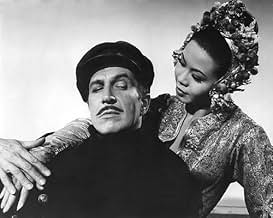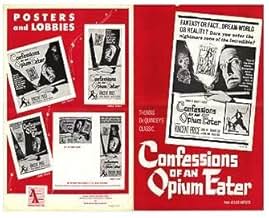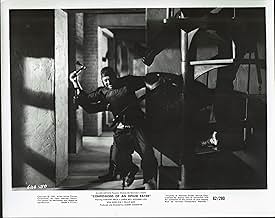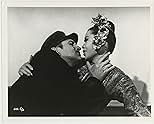Confessioni di un fumatore d'oppio
Aggiungi una trama nella tua linguaIn 19th-century San Francisco's Chinatown, American adventurer Gilbert De Quincey saves slave girls owned by the Chinese Tong factions.In 19th-century San Francisco's Chinatown, American adventurer Gilbert De Quincey saves slave girls owned by the Chinese Tong factions.In 19th-century San Francisco's Chinatown, American adventurer Gilbert De Quincey saves slave girls owned by the Chinese Tong factions.
- Lotus
- (as June Kim)
- Lo Tsen
- (as Caroline Kido)
- First Dancing Girl
- (as Joanne Miya)
- Auctionieer
- (as John Mamo)
Recensioni in evidenza
The dialogue is surprisingly lyrical, and it's a huge benefit to the film that Vincent Price is on hand to deliver it. Price's voice always bodes well with dialogue like this, and that doesn't change here. Confessions of an Opium Eater was filmed in black and white, and while the cinematography looks rather cheap; it does fit the feel of the film. Vincent Price takes centre stage at almost all times, and while there are some memorable characters among the supporting cast - it is always clear that this is Price's film. The film is directed by Albert Zugsmith; and the fact that he is better known for his producing credits is hardly surprising as his direction isn't exactly inspiring...but then again, you can't expect brilliance in a B-movie picture like this one. There are a number of standout moments in the film, however, and chief among them is Price's hallucination sequence; which somehow manages to blend well with the rest of the picture. Overall, Confessions of an Opium Eater is a film that is well worth tracking down despite not being one of price's out and out best efforts, and I highly recommend it.
Ah, 1962. Producer/director Albert Zugsmith evidently met his Muse and cranked out this gleefully un-PC look at the Yellow Peril in San Francisco 1902. Zugsmith, despite some legitimate credits on his resume, wallowed in exploitation for the most part. COAOE somehow escaped Zugsmith's penchant for low-level production and rose above what should have been a Z-list production. What resulted was a real oddity, a bastardized version of Thomas De Quincey's late 1800s drug tale. This movie bears little resemblance to De Quincey's fable. The screenplay is more Sax Rohmer/Fu Manchu than anything else.
This drive-in classic has it all folks. Enigmatic fortune cookie wisdom, secret passages out the yin-yang, a sultry Dragon Lady named Ruby with world domination on her mind, a wisecracking Chinese Munchkin sing-song girl, Polynesian twerking, firecrackers, Tong warfare, every Chinese actor in Hollywood, Vincent Price as a moody poetic sort of action hero...and yes, opium. Price's opium dream is a real hoot for fans of late 1950s Allied Artists horror/sci-fi flicks. After nodding off on the pipe, Vinny gets visited by a host of critters from other AA pics in short cameo appearances. He sees the "eyeball hand" from Invasion of the Saucermen, crawling along. He sees the monster tarantula from The Spider. He sees the "voodoo woman" from Voodoo Woman. He sees the skull from Screaming Skull. Also lots of Chinese masks and fish-eye lens howling people. Zugsmith really raided the AA vaults to put this trip together.
The famous slo-mo scene, done in complete silence, is still pretty effective. It's surreal, dreamy, and unexpected. Also of note is the "girl auction" in which captive gals from the United Nations perform native dances for the Mandarin crowd and their impressive wisdom hats. Watch for Miss Polynesia, who really does twerk, in addition to writhing around to a soundtrack that switches from ersatz Chinese to SF North Beach beatnik coffee bar free form jazz. Tasty!
Well worth seeking out if you've heard about this. It's short and to the point. Also extremely weird. The ending is unexpected. Over fifty years later, a movie like this could not be made. There are racial stereotypes presented in an unapologetic manner, strictly due to the time in which it was made.
Anyway, how can you resist a movie that owns the line: "NO! Use the velvet whips, they don't mar the body!" Delicious.
Nominally based on Thomas De Quincy's CONFESSIONS OF AN ENGLISH OPIUM EATER, it seems a mildly incoherent, sloppily composed movie. On the other hand, there is the implication that this is all an opium dream, which would go a ways towards explaining the lack of sense. Given that the producer-director, Albert Zugsmith, was a hard-working man who had produced movies like Orson Welles' TOUCH OF EVIL and directed SAPPHO DARLIng, I'll come down in the middle. I think he intended this to be an opium dream, but given the script by Robert Hill, the remnants of the Production Code, and his own less than stellar talents, it's not a great success. Still, it provides a chance to see a lot of Studio Era actors like ichard Loo, Phillip Ahn, and Victor Sen Yung.
Lo sapevi?
- QuizIndirectly led to the creation of the famed East West Players. Many of the Asian actors, including a young James Hong, were incensed after the only roles they were offered were "opium dope people and the prostitutes and so forth." After a petition to producer Albert Zugsmith fell on deaf ears, Hong co-founded the East West Players to give Asian-American actors more meaningful, non-stereotypical roles.
- BlooperThis film takes place in the 19th century, as stated, and seen in the townspeople's dress. But in the beach scene, a Thompson machine gun is used; this wasn't available until after 1918.
- Citazioni
Gilbert De Quincey: [narration] When the dreams of the dark, idle, monstrous phenomenae move forever forward... wild, barbarous, capricious into the great yawning darkness... to be fixed for centuries in secret rooms. De Quincey, the artist? De Quincey, the pagan priest, to be worshipped, to be sacrificed. What is a dream and what is reality? Sometimes a man's life can be a nightmare; other times, cannot a nightmare be life? And the voices that I heard, were they the voices of some strange imitation of men in some strange, writhing jungle of my imagination? Was this opium or was it reality? Was I dead? Or I was I only beginning to live?
- ConnessioniEdited from Voodoo Woman (1957)
I più visti
- How long is Confessions of an Opium Eater?Powered by Alexa
Dettagli
- Data di uscita
- Paese di origine
- Lingua
- Celebre anche come
- Confessions of an Opium Eater
- Luoghi delle riprese
- Azienda produttrice
- Vedi altri crediti dell’azienda su IMDbPro
- Tempo di esecuzione
- 1h 25min(85 min)
- Colore
- Proporzioni
- 1.37 : 1






























